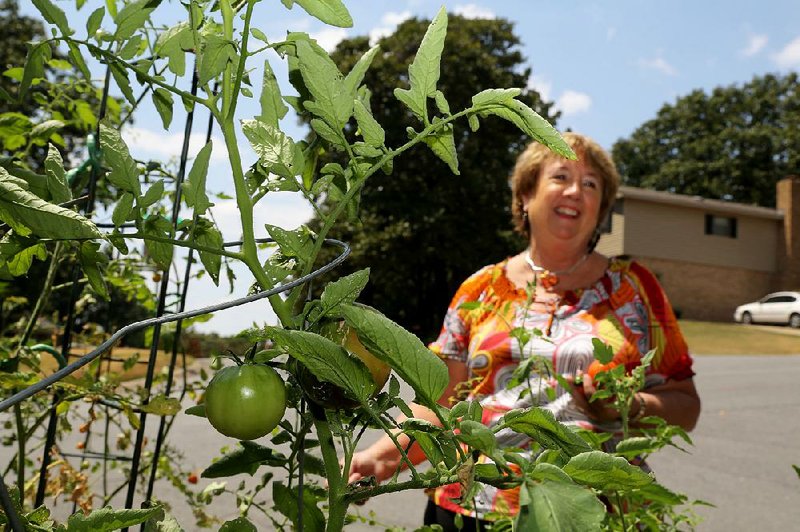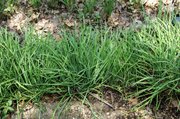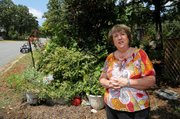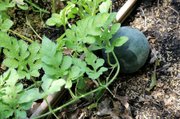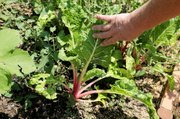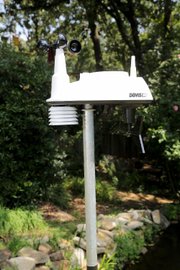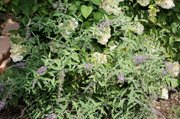The work that Janet Carson takes home needs watering.
Carson's how-to-grow-it advice column, "In the Garden," appears every Saturday on this page in the Democrat-Gazette's Style section. She is a horticulture specialist for the University of Arkansas Cooperative Extension Service, and coordinator of the state's Master Gardener program.
At home, "I try to practice what I preach," she says. Flowers and vegetables, herbs and other greenery and a water garden surround the cultivation columnist's house in Little Rock.
How well does Carson's advice work for her? On a shaded corner lot that makes gardening especially tricky? In the front yard, in order to catch as much sunlight as possible?
She points to the bright red success of her cherry tomatoes -- steadily more than a salad's worth.
"I enjoy being outside," she says. "I love, when I'm going to cook, to go outside and pick something to eat."
"Outside" always did mean just outside the house to her, not out in the fields. Born a city girl, she does most of her gardening in raised, boxed beds a few feet from the front door.
"I say the key is to bring in good soil," she says, "which I did."
She is the state's voice of gardening expertise on radio and TV, and online, as well as through the newspaper, having joined the extension service in 1980. But how does her garden grow?
No silver bells and cockle shells, but this summer's potatoes came on by the pound, she says -- and tomatoes and basil and, if cheese grew on a vine, she would have the classic salad combination, tomato-basil-mozzarella.
Herbs interspersed with flowers create a decorative array that Carson learned from her son, a chef, to call edible landscaping. The idea is to plant as many things as possible for taste as well as appearance.
Pineapple sage: good for flavoring tea. Fennel: a spice and salad garnish. Tapioca plant:
the source of tapioca pudding. Lemon grass: a staple of Asian cooking.
She has prospects of nibbling blueberries and figs, too, but hold the lotus that grows in the water garden. The lotus-eaters of Greek mythology were made blissfully lazy by their diet of lotus blossoms.
Hardly so, Carson keeps track of more than 3,000 Master Gardeners and their volunteer projects in 67 counties. With a master's degree in horticulture from the University of Arkansas at Fayetteville, what can't she grow?
"I tried artichokes this year," Carson says. "They bit the dust."
"I tell people, if you've never lost a plant, then you're not trying different things."
Kale is a variety of cabbage, and, well -- truth told, the expert's patch of kale wound up with the gray-green look of tough to chew. She concedes it had the look of August, another dry August, temperatures near and above 100 degrees, the sky a bleached blue, some of the neighbors' yards gone brown.
But no fair calling fault on that ornamental sprig with the droopy, yellow-browning leaves by the pond. It's a buckeye, Carson says, and it looks like a buckeye naturally does this time of year.
"I tell people not to plant one by the front door," she says, and hers is nowhere near calling attention to its dejected self near the entry.
She counts this summer's success in terms of "lots of peppers," hot and mild, and Swiss chard with healthy pink stalks, and softball-size sugar baby watermelons.
The flowers -- zinnias, moonflowers, hydrangeas -- she rates "OK" for the season.
She deals with the same gardening problems as any other working person with job responsibilities that sometimes take priority over the roses and raspberry bushes.
Her rule is to "walk the garden every day" in order to give prompt attention to leaf-chewing bugs, weeds and other troubles that are apt to spread. But her job requires travel throughout the state for days at a time. Those days, she relies on an automated sprinkler system.
All in all, she tries for a half-hour's home gardening after work most days, and a good four hours at least on the weekend.
In fact, some of the issues she confronts in her own garden might sound like the questions that readers of her column write in:
QUESTIONS, QUESTIONS
• Q: My yard is basically a sprinkle of dirt over solid rock. I want potatoes, but I can't even grow weeds. Now what?
"Rich soil is the foundation to a garden," Carson says. But dirt isn't always as common as, well -- dirt.
She and her husband, Clay, bought their home in Little Rock 17 years ago. With two children to bring up she didn't give much thought at first to raising vegetables.
But she did want the water garden -- a fish pond with a little waterfall. It was then she discovered the hole was not a digging project to be scooped out, but a rock-scraping job for a backhoe.
"You can't dig in rock." she says, and kept in mind that nature was going to need help when the time came to have a garden.
Children grown, she hauled in a truck load of soil that a potato could love, and planted in a double-high raised bed.
• Q: My house is surrounded by shady oaks. The backyard doesn't get enough sunlight to keep a garden going. Is this hopeless, or what?
Carson's house is on a corner lot, and the garden is out front.
Some neighborhood associations won't allow front-yard gardening, she says. But it's no problem where she is for a St. Louis-born city girl to go country on the corner.
Neighbors stop to ask what she has going out there, she says, and some go off to try the same moves in their own gardens.
• Q: I want a garden, but how do I keep it to a manageable size?
Raised garden beds like hers are basically container gardens, Carson says.
Gardening supply stores sell kits that make a box, often of cedar, to fill with dirt, typically 10 inches deep. Small kits enclose a 4-by-4-foot square for about $50. Larger setups double and triple that size.
The boxes can be stacked for deeper planting, or made into tiers.
Elevated garden beds -- like Carson's herb garden -- look like boxes on table legs.
Four or five boxes might not look like Old MacDonald's idea of acreage, but "we have way more produce than we can eat," Carson says.
Her advice is to start the way she did, with one bed, and see what works -- especially in a spot that never supported a garden before. A pot on the porch can be a garden.
"Start small," she says. "Some people get going with the idea of a huge garden, and they don't realize how much maintenance is involved. Start small, and build on that."
• Q: The weeds are taking over. So many weeds, I don't have time for the garden. All I do is pull weeds. How can I grow anything besides weeds?
Carson spreads cardboard over the ground to stifle weeds, adding layers and more layers of mulch on top of the cardboard as the growing season progresses.
"I go through probably 70 bags of mulch," she says.
The mulch breaks down, and in time, so does the cardboard. But meantime, she says, this trick keeps the weeds to a minimum around her garden beds.
DIG, DIG AGAIN
This year dealt the state's gardeners triple trouble, Carson says. A late spring, a wet start to summer and a blistering finish squelched a lot of vegetables.
But the end of summer signals a chance to start over, replanting for the fall.
Fall starts Sept. 23 -- by the calendar. But Carson already has plans, immediate and long-range, for what to try next in her home garden.
Potatoes, green beans and squash, she has in mind.
And not now, but one of these days -- chickens.
"Egg-laying chickens," she says. "I want to start with five."
The newspaper has no advice column in the matter of chicken farming, so this might be a time for her to ask somebody else's guidance.
Her job is telling other people how to have a garden, and she is her own best follower of Janet Carson's advice.
"I love it," she says, "I really do."
HomeStyle on 09/05/2015
